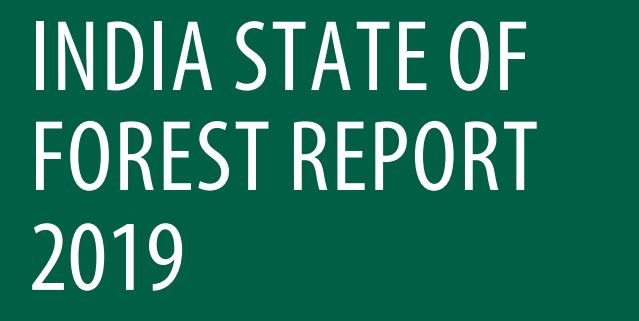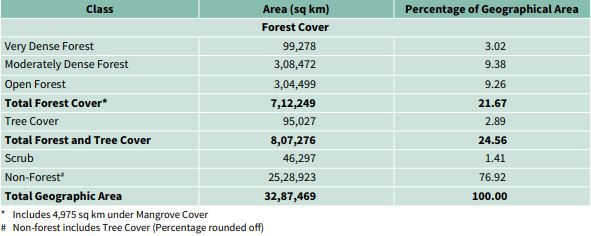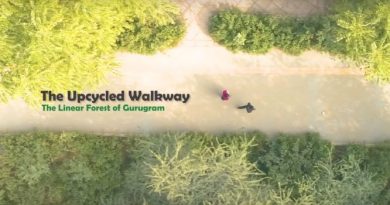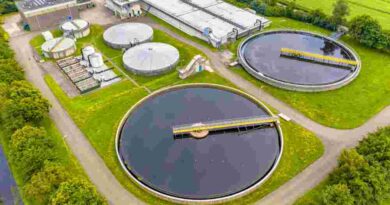Indian Forest Cover Report 2019-Highlights
 ISFR 2019 Launched
ISFR 2019 Launched
The Forest Survey of India (FSI), a body under the Ministry of Environment, Forests and Climate change, headed by Union Minister Prakash Javadekar has released its report for 2019. The two volume India State of the Forest Report 2019 report (ISFR 2019), the 16th in the series since the first report in 1987, was released by Mr Javadekar at a ceremony in New Delhi today. FSI is headed by Dr. Subhash Ashutosh, Director General.
The ISFR 2019 report serves as a critical barometer of the pressure on our forests, and the success of efforts being made to preserve and even grow these critical resources. Now considered all the more important for the massive opportunity they present to serve as a carbon sink, to meet the country’s National goals under the Paris accord. India, with 2.5% of the total land surface on earth supporting 16% of human and 18% of cattle population of the world, faces an even tougher challenge than people imagine in doing this.
In the current cycle, the headline number is undoubtedly the net increase of over 5000 sq km of forest and tree cover as compared to the
previous assessment.
Before we get into the findings, it should be noted that the ISFR 2019 report, considers as a forest all patches of land with a tree canopy density of more than 10% and more than 1 ha in area, irrespective of land use, ownership and species of trees.

Source: India State of Forest Report-2019
This year’s report uses data from a new grid based forestry inventory design adopted by FSI in 2016, which ensures higher sampling intensity with uniformly spread sample plots across the country leading to higher precision.
So lets move to the key findings:
♦ The total forest cover of the country is 7,12,249 sq km which is 21.67% of the geographical area
of the country. The tree cover of the country is estimated as 95,027 sq km which is 2.89% of the
geographical area.
♦ The total Forest and Tree cover of the country is 8,07,276 sq km which is 24.56% of the geographical
area of the country.
♦ The current assessment shows an increase of 3,976 sq km (0.56%) of forest cover, 1,212 sq km
(1.29%) of tree cover and 5,188 sq km (0.65%) of forest and tree cover put together, at the national
level as compared to the previous assessment i.e. ISFR 2017.
♦ The top five States in terms of increase in forest cover are Karnataka (1,025 sq km), Andhra
Pradesh (990 sq km), Kerala (823 sq km), Jammu & Kashmir (371 sq km) and Himachal Pradesh
(334 sq km).
♦ Forest cover in the hill districts of the country is 2,84,006 sq km, which is 40.30% of the total
geographical area of these districts. The current assessment shows an increase of 544 sq km
(0.19%) in 140 hill districts of the country.
♦ The total forest cover in the tribal districts is 4,22,351 sq km, which is 37.54% of the geographical
area of these districts. The current assessment shows a decrease of 741 sq km of forest cover
within the RFA/GW in the tribal districts and an increase of 1,922 sq km outside.
♦ Total forest cover in the North Eastern region is 1,70,541 sq km, which is 65.05% of its geographical
area. The current assessment shows a decrease of forest cover to the extent of 765 sq km (0.45%)
in the region. Except Assam and Tripura, all the States in the region show decrease in forest cover.
♦ Mangrove cover in the country has increased by 54 sq km (1.10%) as compared to the previous
assessment.
♦ The total growing stock of wood in the country is estimated 5,915.76 million cum comprising
4,273.47 million cum inside forest areas and 1,642.29 million cum outside recorded forest areas
(TOF). The average growing stock per hectare in forest has been estimated as 55.69 cum.
♦ Total bamboo bearing area of the country is estimated as 1,60,037 sq km. There is an increase of
3,229 sq km in bamboo bearing area as compared to the estimate of ISFR 2017.
xiii
♦ Soil Organic Carbon (SOC) represents the largest pool of carbon stock in forests, which has been
estimated 4,004 million tonnes. The SOC contributes 56% to the total forest carbon stock of the
country.
♦ There are 62,466 wetlands covering 3.83% of the area within the RFA/GW of the country. The total
number of wetlands located within the RFA/GW is 8.13%. Amongst the States, Gujarat has largest
area of wetlands within RFA in the country followed by West Bengal.
♦ Dependence of fuelwood on forests is highest in the State of Maharashtra, whereas, for fodder,
small timber and bamboo, dependence is highest in Madhya Pradesh. It has been assessed that
the annual removal of the small timber by the people living in forest fringe villages is nearly 7% of
the average annual yield of forests in the country.
Even as experts will now delve deeper into the report to understand its findings, and possibly contentious issues too, there remains no doubt that the report deserves to be shared, and understood more widely, to ensure that we understand the impact, value and relevance of our forest resources better.




